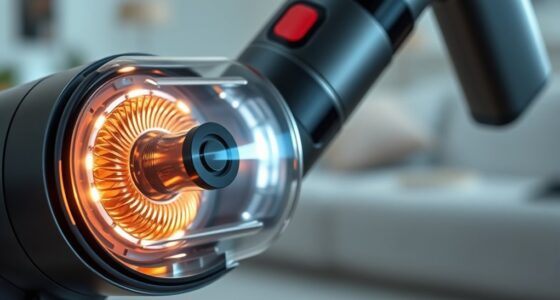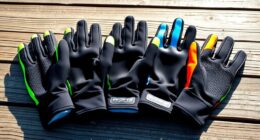LiDAR mapping transforms your robot vacuum’s accuracy by creating detailed, real-time 3D maps of your home. It allows the device to precisely detect obstacles, plan ideal routes, and avoid missed spots or collisions. With better navigation, your vacuum uses less power and cleans more thoroughly. Enhanced mapping also adapts to changes in your environment, ensuring consistent performance. To discover how this technology elevates your cleaning experience, keep exploring further.
Key Takeaways
- LiDAR provides precise 3D environmental data, enabling accurate map creation and obstacle detection for better navigation.
- Proper calibration of LiDAR sensors ensures consistent mapping accuracy and reduces errors like missed spots.
- High-quality mapping allows optimized route planning, reducing cleaning time and conserving battery life.
- Continuous mapping updates help the vacuum adapt to changes, improving obstacle avoidance and cleaning thoroughness.
- Compared to traditional sensors, LiDAR offers superior spatial awareness, resulting in more efficient and reliable cleaning performance.
Understanding LiDAR Technology in Home Cleaning Devices
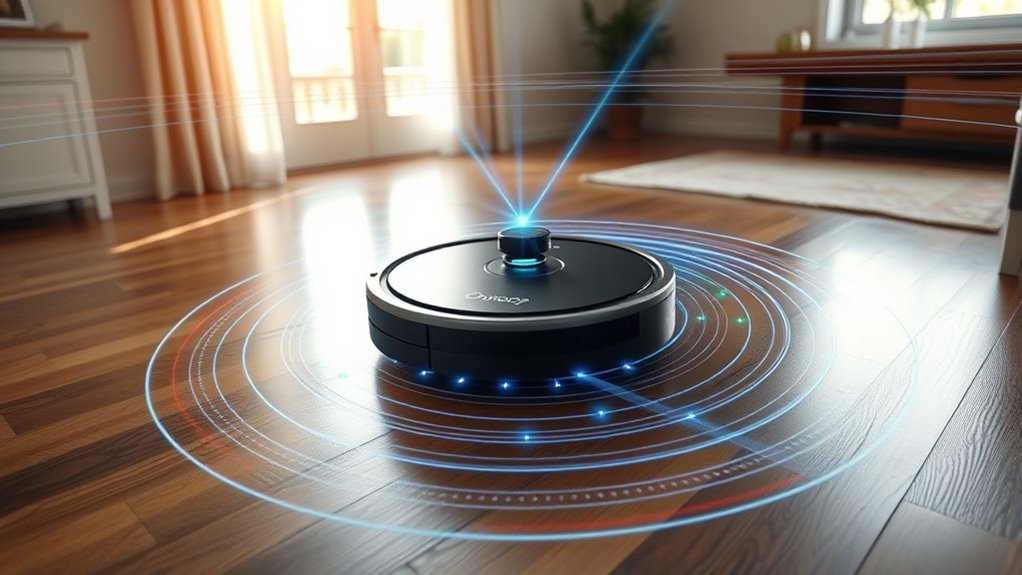
LiDAR technology has become a key component in modern home cleaning devices because it enables precise mapping and navigation. To guarantee optimal performance, sensor calibration is essential; it helps the device accurately interpret surroundings and avoid obstacles. Proper calibration reduces errors that could lead to missed spots or collisions. Additionally, LiDAR systems are designed with battery optimization in mind, balancing power use with sensing accuracy. When sensors are calibrated correctly, the vacuum doesn’t waste energy repeatedly scanning the same areas or making unnecessary adjustments. This efficient use of power extends battery life, allowing your device to clean longer without recharging. Furthermore, contrast ratio plays a role in how well the device perceives its environment in varying lighting conditions. In essence, understanding the importance of sensor calibration and battery optimization ensures your robot vacuum operates smoothly and efficiently, making your cleaning routine more effective.
How LiDAR Creates Detailed 3D Home Maps
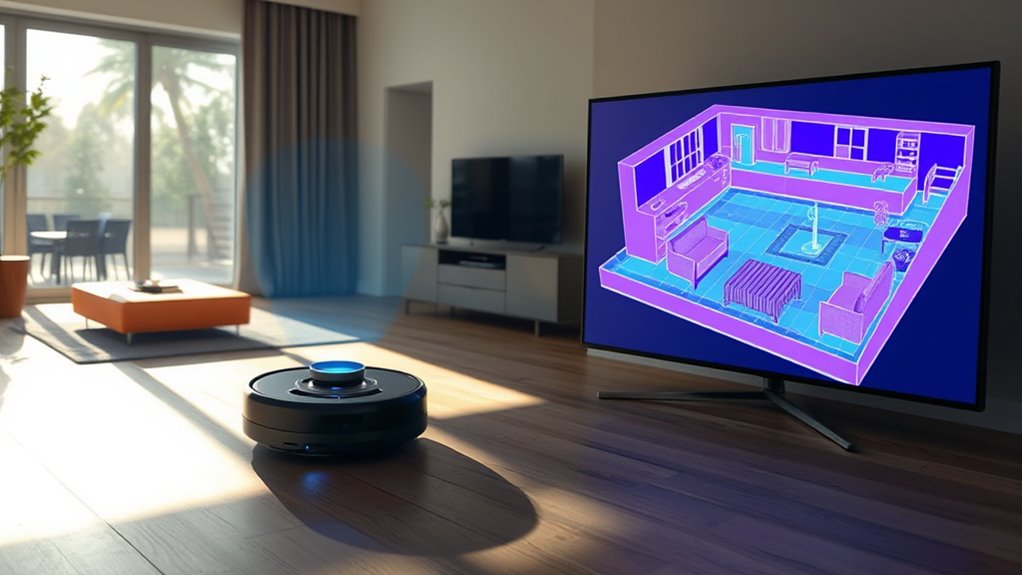
By accurately calibrating sensors, your robot vacuum can gather high-quality data about its environment. This data enables it to create detailed 3D home maps with high mapping precision. LiDAR sensors scan your space by emitting laser beams that reflect off surfaces, allowing the device to measure distances exactly. The key is sensor integration; combining LiDAR data with other sensors, like cameras or bump sensors, enhances the accuracy of the map. As your vacuum moves, it continuously updates this map, recognizing obstacles and layout features. This detailed 3D mapping gives your robot a thorough understanding of your home’s structure, helping it navigate efficiently and avoid errors. Proper headphone setup can also improve user experience when monitoring or controlling your device remotely. Ultimately, this precise mapping process ensures thorough cleaning and smarter operation.
The Impact of Accurate Mapping on Cleaning Efficiency
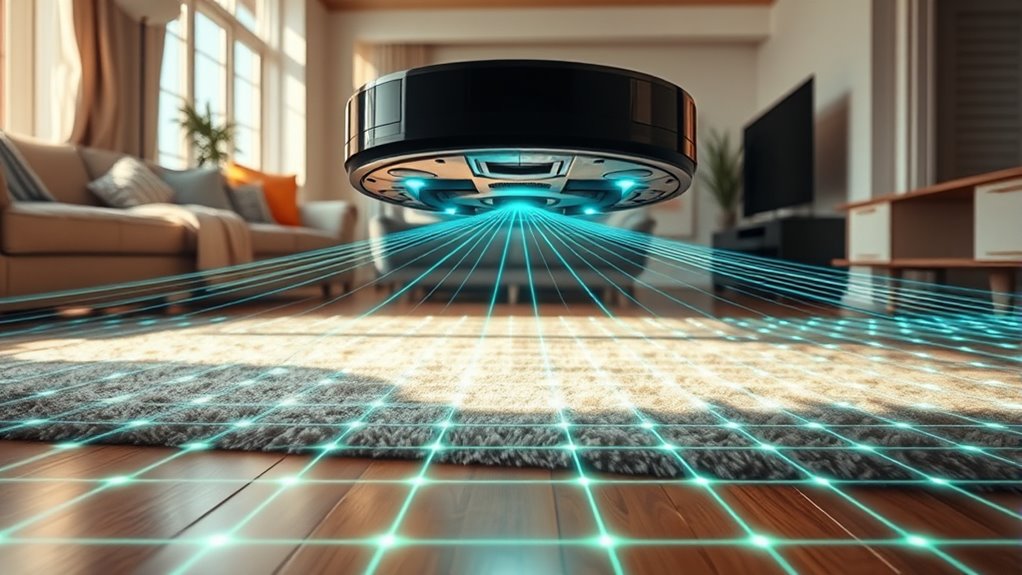
When your robot vacuum has an accurate map of your home, it can plan cleaning routes more effectively and avoid unnecessary backtracking. This precision reduces dust accumulation in missed spots and guarantees thorough cleaning. It also conserves battery life by optimizing movement, which prolongs battery longevity. Additionally, precise mapping can help identify tuning improvements that enhance overall performance. You can visualize this with the following:
| Area Type | Cleaning Focus | Benefits |
|---|---|---|
| Living Room | High dust accumulation | Better dust removal |
| Kitchen | Food debris & spills | Efficient coverage |
| Hallways | Frequent foot traffic | Faster, complete cleaning |
Obstacle Detection and Avoidance With Lidar
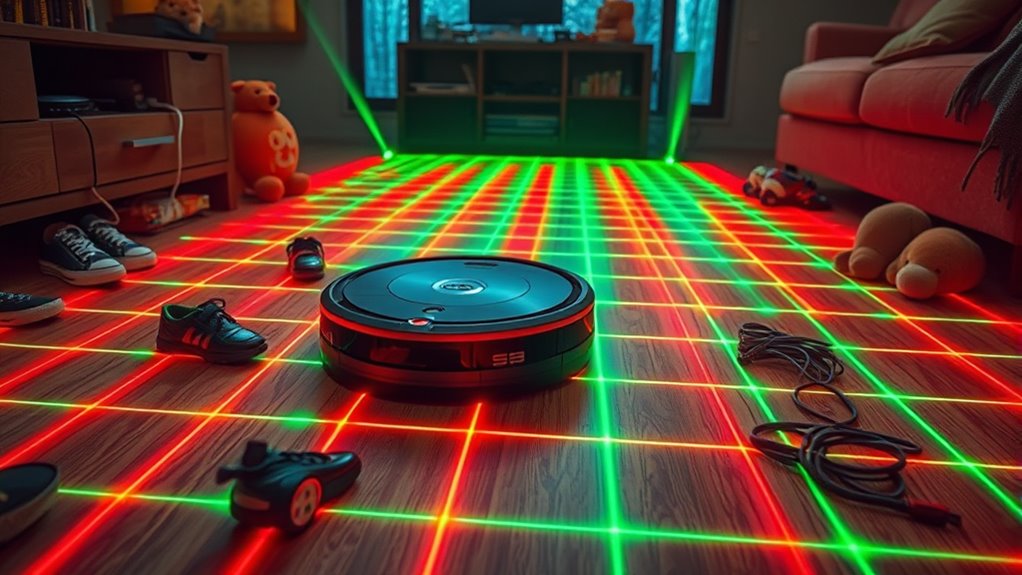
Obstacle detection and avoidance with LiDAR substantially enhance a robot vacuum’s ability to navigate your home safely and efficiently. By continuously calibrating sensors, the system maintains high accuracy in detecting obstacles like furniture or cords, reducing collisions. Proper sensor calibration ensures that the vacuum responds quickly and precisely, preventing damage and missed spots. This efficiency also benefits your device’s battery life, as fewer collisions mean less unnecessary power use. When obstacles are identified early, the vacuum can plan ideal routes, avoiding delays and conserving energy. Additionally, understanding sensor calibration is crucial for maintaining optimal performance over time. Overall, LiDAR’s real-time obstacle detection helps you enjoy a thorough clean without interruptions, extending your robot vacuum’s longevity and maintaining peak performance through consistent sensor calibration.
Comparing Traditional and LiDAR-Enabled Robot Vacuums
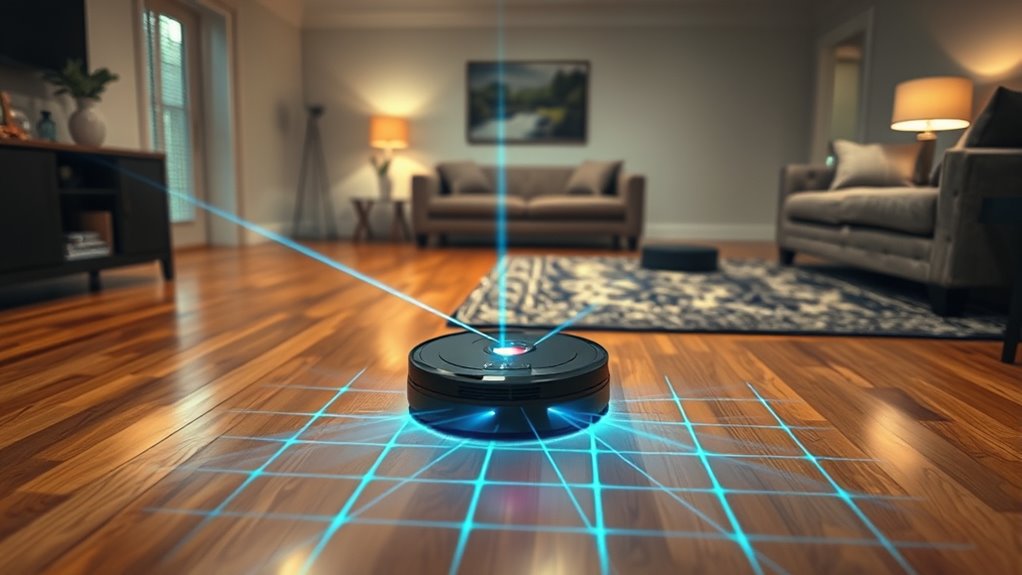
Traditional robot vacuums rely on simple sensors and basic navigation algorithms, which can lead to missed spots and frequent collisions. They often have shorter battery life because their inefficient cleaning paths require more power, and they tend to be noisier due to less advanced motor control. In contrast, LiDAR-enabled vacuums use sophisticated mapping to optimize cleaning routes, conserving battery and reducing cycle times. This precision means you get more thorough cleaning with fewer passes, saving battery life. Plus, with better navigation, noise levels are often lower since the vacuum moves smoothly and avoids unnecessary bumping or repeated coverage. Overall, LiDAR technology markedly improves both cleaning efficiency and user experience compared to traditional models. Additionally, advancements in Kia Tuning demonstrate how precise adjustments can enhance overall vehicle performance, similar to how LiDAR mapping optimizes robotic cleaning.
Enhancing Navigation in Complex Home Environments
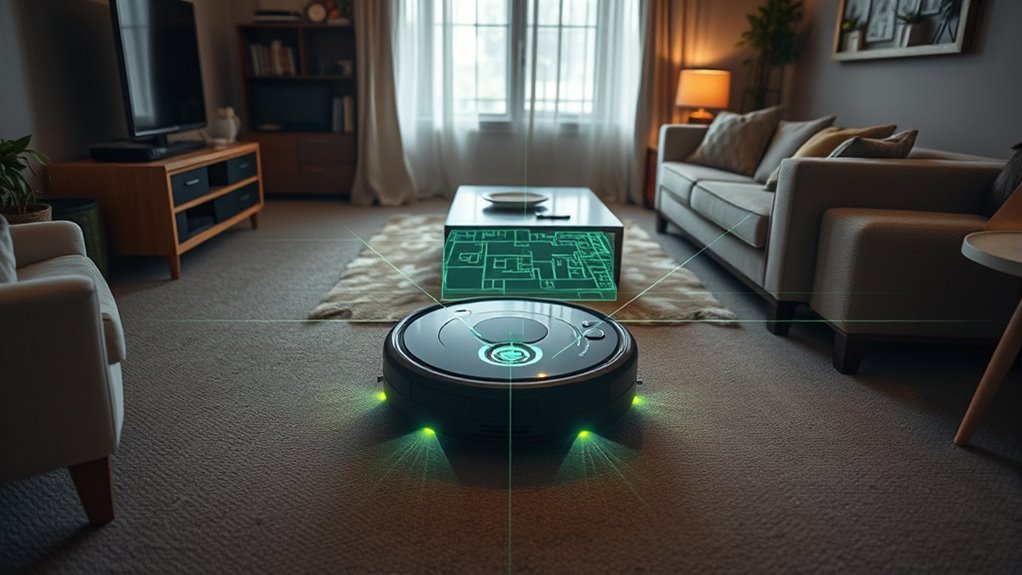
Exploring complex home environments presents a significant challenge for robot vacuums, especially in spaces with clutter, multiple floor types, or tight corners. To steer effectively, your vacuum uses LiDAR mapping to identify obstacles and plan optimal routes. It adapts to:
- Moving around furniture and clutter without getting stuck
- Shifting smoothly between hardwood, tile, and carpet floors
- Navigating tight spaces and corners with precision
Smart home integration allows your vacuum to receive real-time updates and control via apps, enhancing navigation. Additionally, efficient battery management ensures the vacuum can cover large areas without interruption, returning automatically to recharge when needed. Together, these features enable your robot vacuum to clean thoroughly and adapt seamlessly to complex environments.
Future Developments in LiDAR and Robot Vacuum Technology
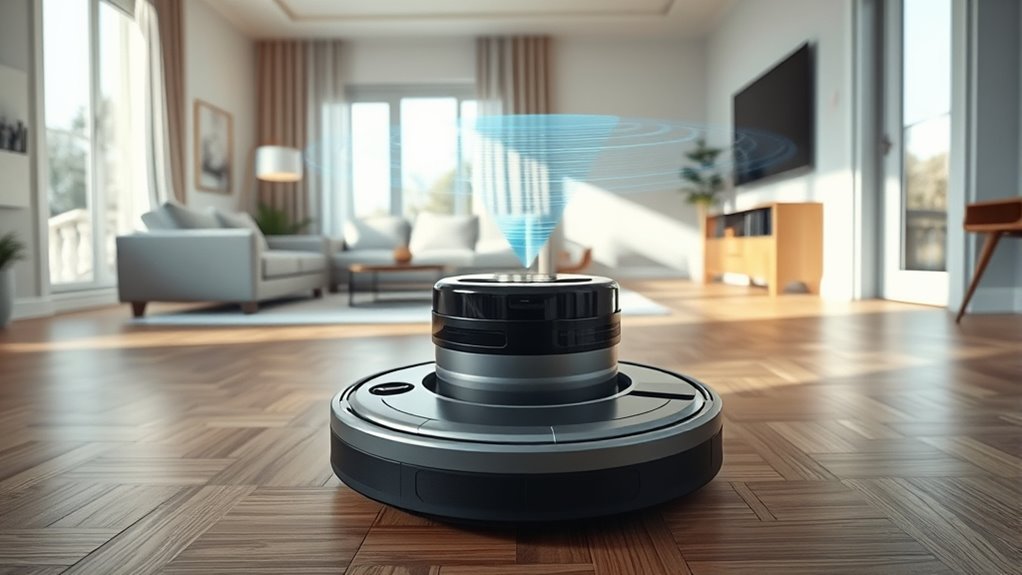
Advances in LiDAR technology are poised to revolutionize how robot vacuums navigate and clean your home. Future developments will focus on better sensor integration, enabling vacuums to combine LiDAR data with cameras and other sensors for even more accurate mapping. This will allow your device to adapt seamlessly to changing environments and avoid obstacles more effectively. Additionally, innovations in battery optimization will extend cleaning cycles without sacrificing performance. Enhanced power management will ensure that LiDAR systems operate efficiently, reducing energy consumption and increasing operational time. These improvements will make robot vacuums smarter, more reliable, and better suited to handle complex home layouts, giving you a more thorough and efficient cleaning experience. Incorporating Toyota Tuning principles can inspire the development of more robust and adaptable sensor systems, further enhancing overall device performance.
Frequently Asked Questions
How Does Lidar Improve Battery Life in Robot Vacuums?
LiDAR improves battery life in robot vacuums by enhancing battery optimization and power efficiency. It helps your vacuum navigate more precisely, avoiding unnecessary movements and reducing energy waste. With smarter mapping, your device conserves power by focusing only on areas that need cleaning and avoiding obstacles. This targeted approach means your vacuum uses less energy overall, extending battery life and ensuring more effective cleaning sessions without frequent recharging.
Can Lidar Detect and Avoid Small or Transparent Objects Effectively?
Did you know LiDAR can detect objects as small as 2 centimeters? When it comes to small objects and transparent detection, LiDAR’s effectiveness depends on the object’s material and size. While it’s great at mapping environments, it can struggle with transparent objects like glass or thin curtains. So, for tiny or see-through obstacles, some robot vacuums may still need additional sensors to improve avoidance.
What Maintenance Is Required for Lidar Sensors in Home Devices?
You should regularly perform sensor calibration to guarantee your LiDAR sensors stay accurate. Keep the sensors clean by removing dust and debris, which can affect their performance. Check for any smudges or obstructions and gently wipe the sensor surface with a soft cloth. Doing this maintenance helps your home device’s LiDAR sensors function at their best, providing precise mapping and obstacle detection for better cleaning results.
How Does Lidar Handle Dynamic Changes in Home Layouts?
When dealing with dynamic obstacle detection and layout adaptability, LiDAR excels by constantly updating its environment scans. You’ll notice it quickly detects moving objects, adapts to new furniture placements, and navigates around changing layouts. This real-time sensing allows your robot to respond swiftly, avoiding obstacles efficiently. By continuously mapping and re-mapping, LiDAR guarantees smooth navigation despite home changes, providing reliable, accurate cleaning without missing spots or bumping into new obstacles.
Are There Privacy Concerns With Lidar Data Collection in Homes?
You might wonder about privacy concerns with LiDAR data collection in homes. While LiDAR helps improve cleaning efficiency, it also gathers detailed spatial data, raising questions about data security. Manufacturers typically implement encryption and strict data policies to safeguard your privacy. However, staying informed about how your data is used and choosing brands that prioritize data security helps ensure your personal space remains private and secure.
Conclusion
By upgrading to LiDAR-enabled robot vacuums, you’re stepping into a future where your home’s layout is mapped with laser-sharp precision—like a master cartographer charting uncharted territory. This technology transforms cleaning into a seamless, efficient adventure, avoiding obstacles with ease and reaching every corner. Embrace this innovation, and watch your cleaning routine become as effortless as a breeze sweeping through a perfectly mapped maze—truly revolutionary.



